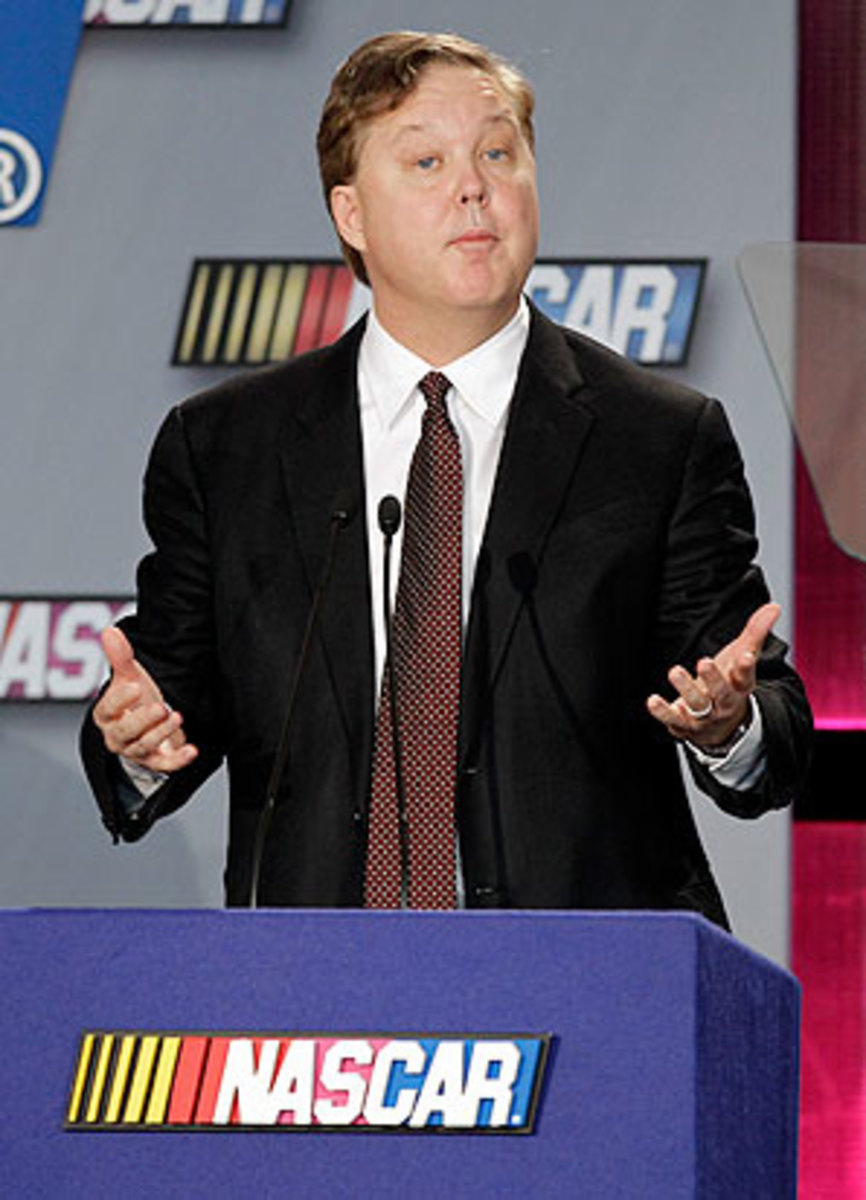
Confident NASCAR stands pat on the Chase, but builds for the future
So rather than tinker with a successful formula, NASCAR CEO Brian France and president Mike Helton have largely taken an "If it ain't broke; don't fix it" attitude this season.
"We enter this season with optimism," France said Thursday at the NASCAR Hall of Fame on the final day of the Sprint Cup Series Media Tour. "The championship was perhaps the best ever, so we want to keep the momentum going. Our focus in 2012 is to continue that momentum. The sport is in a very good place right now."
Much of the success can be attributed to an epic Chase that saw Carl Edwards and Tony Stewart wage a neck-and-neck battle for the title. France believes that initiatives announced a year ago made that battle possible.
"Last year at this event we announced a number of changes that we believed would build interest and help make it easier for fans to understand the championship race," France said. "We're very pleased with how all of those changes played out. Adding a wild card brought significant drama in the summer. It put a premium on winning ... and put all of the drivers in the top 20 in points relevant to the championship. Simplifying the points system was also a good move to our partners and our fans.
"The championship battle will be talked about for a long, long time. No question about it, Tony Stewart and Carl Edwards gave us an incredible show that was exciting all the way to the last lap. In the end, it came down to victories and that is exactly how it should be."
NASCAR standing pat on the playoff is fairly notable. Fans of the sport will note that the Chase has been tweaked nearly every year since its inception, in 2004. NASCAR expanded the field from 10 to 12 in 2007 and last year simplified the Chase scoring and added two wild-card entries.
Despite the continuity, NASCAR isn't sitting in neutral. Far from it actually, as the upcoming year includes the implementation of electronic fuel injection for the first time in series history and rule changes to minimize the use of two-car tandem racing at Daytona and Talladega. And in 2013, NASCAR will move to re-styled Sprint Cup Cars, which will more closely resemble consumer models.
The move to electronic fuel injection, a technology common in passenger cars since 1990, will phase out the highly inefficient carburetor and create additional technological and business possibilities.
"EFI is an important step to make the cars on the track more like the production cars fans drive today and [it] allows us to use smart technology," France said. "Fuel injection is no small thing to introduce. Fuel injection excites the manufacturers. It excites technology companies, and between that ... and the various things we're doing with the 2013 [Sprint Cup cars], our expectation is the car manufacturers are going to increase their support for the teams, increase their activation, which is great for all of us, and they're excited to do that because they feel good about it."
Changes at Daytona will allow a return to pack racing, breaking up the two-car tandem format that was used last year. It will be the first Daytona 500 where electronic fuel injection (EFI) will be utilized. A restrictor plate measuring 29/32 inch will be used to control speeds. A larger spoiler and softer springs will be used and the rear bumper will be two inches lower.
"I think we have some confidence that the tandem racing that we saw 2011 conclude with won't be a part of the Daytona 500," Helton said. "But we're not going to write a rules package that prevents the drivers from racing close to each other. That's NASCAR racing that fans expect. So we think the Daytona 500 will be more in line with the fans' expectations, and you'll see more than likely cars push each other, but that was happening in 1959 and 1979."
In 2007, NASCAR introduced the "Car of Tomorrow". The model eliminated any degree of manufacturer identity, leaving race fans unable to tell the difference between a Ford, a Chevrolet, a Toyota or a Dodge. Helton assured fans that would not be a problem with the 2013 model.
"The optics of the 2013 car will be significantly recognized and very popular," he said.
Earlier this week Ford unveiled its 2013 prototype at Charlotte, showing a Ford Fusion that looks nearly identical to the passenger car.
NASCAR announced private testing with the 2013 car will begin next month as Ford, Chevrolet, Dodge and Toyota have a chance to refine the new product.
After a spectacular season in 2011, NASCAR officials are finally confident they have found the right balance for the near term, but as the 2013 model shows, they aren't neglecting the future either.




